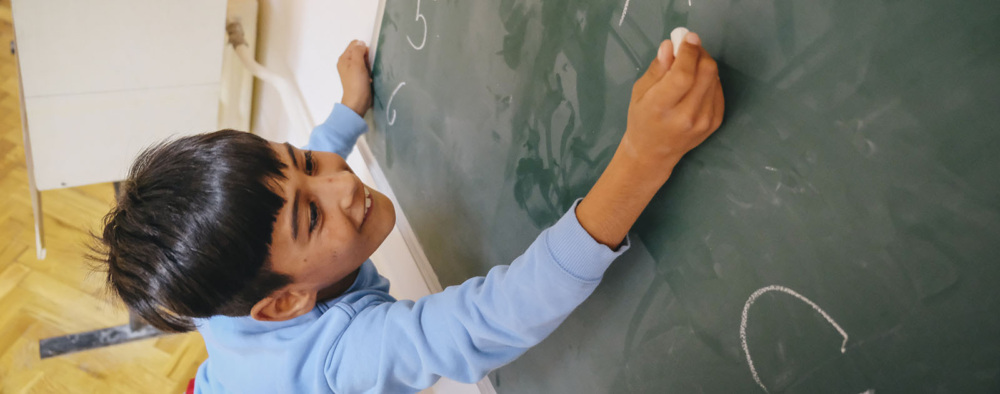
Seguridad y bienestar
Educación, Justicia de género, Seguridad y bienestar, Poder juvenil
En los últimos años, la demanda de una teoría del cambio entre las organizaciones no gubernamentales y las fundaciones internacionales ha aumentado. Sin embargo, la pregunta sigue siendo si las organizaciones están utilizando esta herramienta para el cumplimiento o para la mejora y el aprendizaje estratégicos reales.
En 2018, el Fondo Mundial para la Infancia emprendió el proceso de desarrollo de su teoría del cambio por primera vez. Ahora estamos emocionados de compartir nuestra nueva teoría del cambio. Teoría del cambio Con ustedes, mientras continuamos el camino de cuestionar críticamente qué y por qué están sucediendo los cambios, en qué circunstancias y cuál es nuestra contribución a estos cambios.
La teoría del cambio de GFC es un marco para aumentar la práctica basada en evidencia de la organización y validar sus estrategias e hipótesis detrás del cambio social. Nuestra teoría del cambio nos permite enmarcar mejor nuestros esfuerzos de medición y guiar nuestras decisiones estratégicas.
En otras palabras, nuestra Teoría del Cambio muestra lo que debe suceder para lograr nuestra visión: un mundo donde todos los niños y jóvenes estén seguros, fuertes y valorados.
[image_caption caption=”Niños participan en una actividad con un socio local en Nicaragua. © Kuba Okon” float=””]
 [/caption de imagen]
[/caption de imagen]
Comenzamos este viaje a principios de 2018, mientras atravesábamos cambios organizativos fundamentales, que incluían un nuevo director ejecutivo y una estrategia de concesión de subvenciones renovada. La metodología de la teoría del cambio surgió como un enfoque interesante para ayudarnos a transitar estos cambios complejos, alinear nuestra comprensión del impacto de nuestro apoyo financiero y no financiero a las organizaciones locales y comunicar mejor los resultados de nuestro trabajo a audiencias externas.
GFC contrató a un consultor externo para iniciar el proceso involucrando al personal actual y a una muestra de miembros de la junta directiva, donantes, socios, ex empleados y miembros del Consejo de Liderazgo Juvenil, para recopilar sus opiniones. Asumí el liderazgo de este esfuerzo cuando me uní a GFC en enero de 2019. Después de llevar a cabo varias reuniones de alineación, desarrollar una narrativa para describir nuestra teoría del cambio e identificar qué información necesita y puede medir GFC, llevamos el desarrollo de la teoría del cambio a la empresa.
Al mirar atrás a este proceso de nueve meses, me vienen a la mente algunas preguntas clave:
¿Cuáles han sido los mayores desafíos a la hora de desarrollar nuestra teoría del cambio en GFC? ¿Qué hemos aprendido? ¿Qué sigue?
Al incorporarme a GFC, sabía que basarme en el trabajo de un consultor externo plantearía desafíos interesantes y brindaría oportunidades significativas. Desde el principio, tuve clara una cosa: es fundamental que el personal acepte y se sienta dueño de la teoría del cambio antes de poder ponerla en práctica. Hemos avanzado mucho en la reflexión sobre nuestro verdadero valor para nuestros socios y nuestro papel en el impacto que queremos lograr con los niños y los jóvenes, y en la definición de esto juntos. Ahora debemos seguir trabajando para utilizar la teoría del cambio para impulsar nuestra planificación estratégica y nuestra agenda de aprendizaje.
Uno de los aprendizajes más importantes de este proceso fue la manera en que GFC define su contribución al cambio social. Para GFC, definir el impacto a nivel de nuestros socios fue un momento crucial. Las organizaciones locales no pueden controlar por completo muchos resultados, pero a través de nuestro apoyo financiero y de desarrollo de capacidades, esperamos que aprovechen su influencia para resolver problemas complejos en sus comunidades. También estamos siendo intencionales en cuanto a conectar a nuestros socios en un esfuerzo por generar una mayor colaboración y un mayor impacto.
Si bien el proceso de desarrollo de nuestra teoría del cambio ha sido participativo y transformador, también ha servido como fuente de importantes aprendizajes organizacionales. Está claro que necesitamos reforzar nuestra capacidad interna para utilizar los datos para la toma de decisiones y el aprendizaje. Esto nos ayudará a mejorar el diseño y la ejecución de nuestros programas de concesión de subvenciones, basándonos en evidencia autogenerada.
Finalmente, desarrollar nuestra teoría del cambio fue un proceso más largo de lo que habíamos previsto inicialmente. La flexibilidad para asignar más tiempo del personal a esta tarea, aunque no era ideal, fue al final una decisión positiva. Mantener el impulso y no sobrecargar a las partes interesadas con el proceso fue uno de los actos de equilibrio más importantes que asumimos.
[image_caption caption=”Nuestro socio local, Samburu Girls Foundation, ofrece a las niñas acceso a la educación en Kenia.” float=””] [/caption de imagen]
[/caption de imagen]
Como financiadores, queremos construir relaciones basadas en la confianza con nuestros socios. Al mismo tiempo, también queremos asignar eficazmente nuestros recursos midiendo continuamente el impacto de nuestras subvenciones. Planeamos utilizar nuestra teoría del cambio para mejorar nuestra estrategia de concesión de subvenciones en el futuro.
Recopilaremos más datos sobre los resultados que se producen en los diferentes niveles de nuestra teoría del cambio para validar nuestra concepción del cambio. Utilizaremos la teoría del cambio para crear procesos internos más sistemáticos. También exploraremos nuevas formas de cuestionar nuestra conceptualización del cambio, mediante una evaluación de impacto innovadora y la retroalimentación de los socios. A medida que estos nuevos enfoques evolucionen, esperamos ajustar nuestra teoría del cambio con el tiempo para reflejar los cambios en los entornos complejos en los que operamos y para responder a los nuevos aprendizajes que generemos.
Después de conocer las teorías del cambio de nuestros socios y desarrollar las nuestras, hemos adquirido una mayor comprensión de las complejidades de implementar y medir el impacto, lo que aplicaremos en nuestras alianzas actuales y futuras. Este proceso nos ha ayudado a enfatizar la necesidad de involucrar a nuestros socios en un debate más abierto sobre cómo nuestra relación puede mejorar sus misiones y cómo podemos medir el éxito. juntos.
De cara al futuro, pretendemos utilizar la Teoría del Cambio para formular programas de financiación estratégicos y aumentar la eficacia de la concesión de subvenciones en el ámbito de los derechos del niño.
